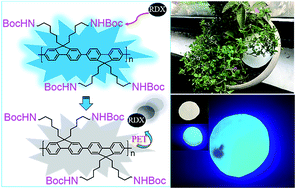Ultrasensitive and direct fluorescence detection of RDX explosive vapor via side-chain terminal functionalization of a polyfluorene probe†
Abstract
3,5-Trinitroperhydro-1,3,5-triazine (RDX), even more devastating than TNT but with an extremely low saturated vapor pressure (4.85 ppt), is often used in military and even terrorist attacks, and so there is a huge demand for its field detection. Conventional detection methods can hardly detect RDX, and no direct vapor detection has been reported based on a fluorescence method because RDX has no aromatic rings and hence it does not have a strong enough interaction with the fluorescent probe. By the introduction of Boc-NH– into the side chain terminal of polyfluorene, a conjugated polymer probe, PF6-Boc, has been designed and synthesized. The probe showed 91% fluorescence quenching in saturated RDX vapor and retained a 66% quenching response even after 8 cycles. A respectable ultrasensitive detection limit of 0.041 ppt was obtained. From simulated landmine detection experiments (RDX buried under sand), the probe showed a significant black quenching spot on the fluorescent filter paper within 5 min and the quenching spots became darker over time, even though the explosives were isolated in the soil and the air flow had a negative effect. The ultra-sensitive sensing performance, reusability and excellent performance in simulation experiments all demonstrate the great potential of PF6-Boc for the direct and on-site detection of RDX. The concept of the functionalization of the side chains of conjugated polymers to facilitate the PET process provides a new route for the detection of very low vapor pressure explosive vapors.

- This article is part of the themed collection: Analytical Methods Recent HOT articles


 Please wait while we load your content...
Please wait while we load your content...